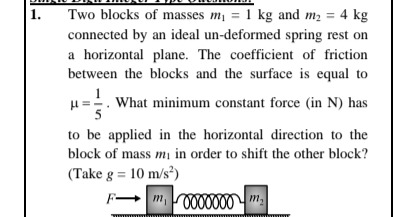Question
Question: Two blocks of masses $m_1$ = 1 kg and $m_2$ = 4 kg connected by an ideal un-deformed spring rest on ...
Two blocks of masses m1 = 1 kg and m2 = 4 kg connected by an ideal un-deformed spring rest on a horizontal plane. The coefficient of friction between the blocks and the surface is equal to μ=51. What minimum constant force (in N) has to be applied in the horizontal direction to the block of mass m1 in order to shift the other block? (Take g = 10 m/s²)

2
4
10
20
10
Solution
To find the minimum constant force F required to shift block m2, we need to analyze the forces acting on both blocks at the moment m2 just begins to move.
1. Condition for block m2 to start moving:
Block m2 will start moving when the spring force (Fs) acting on it to the right overcomes the maximum static friction (fs2,max) acting on it to the left.
The maximum static friction on m2 is given by:
fs2,max=μN2=μm2g
For m2 to just start moving, its acceleration a2 is approximately zero. Therefore, the net force on m2 is zero:
Fs−fs2,max=m2a2=0
Fs=fs2,max
Fs=μm2g
2. Forces on block m1 at the threshold:
At the instant m2 just starts moving, the spring has stretched by an amount such that it exerts a force Fs=μm2g on m2. This same spring force Fs acts on m1 to the left.
The applied force F acts on m1 to the right.
The maximum static friction (fs1,max) acts on m1 to the left.
fs1,max=μN1=μm1g
To find the minimum constant force F, we assume that at this threshold, block m1 is also on the verge of moving, meaning its acceleration a1 is also approximately zero. If m1 were accelerating, a larger force F would be required.
The net force on m1 is zero:
F−Fs−fs1,max=m1a1=0
F=Fs+fs1,max
3. Substitute and Calculate:
Substitute the expressions for Fs and fs1,max:
F=μm2g+μm1g
F=μg(m1+m2)
Now, plug in the given values:
m1=1 kg
m2=4 kg
μ=51
g=10 m/s²
F=51×10×(1+4)
F=2×5
F=10 N
The minimum constant force that has to be applied to block m1 in order to shift block m2 is 10 N.
